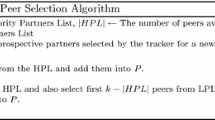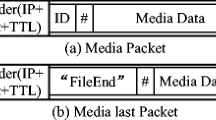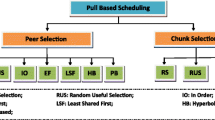Abstract
In current Peer-to-Peer streaming applications, a lot of research attempts to provide timely stream services to the end users. Most of them focus on how to organize the peer connections into an efficient overlay network. Due to the variation in the network, a lot of overhead is generated when the overlay structure adapts to the changes. In order to minimize the impact of network fluctuation, we proposed a scheduling algorithm which helps to distribute stream data efficiently through the fluctuating networks. It needs only partial information about overlay structure and provides the services to satisfy most number of users. The global latency experienced by peers in the system is thus minimized. To alleviate the problem of packet loss along the overlay, we introduce retransmission requests into our scheduling algorithm. Requests for much needed data are treated with higher priority. Parent peers which receive the request will re-send the missing data to minimize the loss impact. The missing data which are needed by more peers will have a larger cumulative impact through the tree overlay and these are thus scheduled and sent earlier. Simulation results showed that our prioritization and scheduling algorithm minimizes the negative impact of fluctuation and data loss in a dynamic network environment.









Similar content being viewed by others
References
Brite (2002). Brite: An approach to universal topology generation. http://www.cs.bu.edu/brite/.
Albert, R., & Barabasi, A. L. (2002). Statistical mechanics of complex networks. Reviews of Modern Physics, 74(1), 47–97.
Banerjee, S., Bhattacharjee, B., & Kommareddy, C. (2002). Scalable application layer multicast. In SIGCOMM ’02: Proceedings of the 2002 conference on applications, technologies, architectures, and protocols for computer communications (Vol. 32, pp. 205–217). New York: ACM.
Banerjee, S., Kommareddy, C., Kar, K., Bhattacharjee, B., & Khuller, S. (2003). Construction of an efficient overlay multicast infrastructure for real-time applications. In INFOCOM 2003. Twenty-second annual joint conference of the IEEE computer and communications societies, IEEE (Vol. 2, pp. 1521–1531).
Castro, M., Druschel, P., Kermarrec, A. M., Nandi, A., Rowstron, A., & Singh, A. (2003). Splitstream: High-bandwidth multicast in cooperative environments. In SOSP ’03: Proceedings of the nineteenth ACM symposium on operating systems principles (pp. 298–313). New York: ACM.
Ganguly, S., Saxena, A., Bhatnagar, S., Izmailov, R., & Banerjee, S. (2005). Fast replication in content distribution overlays. In INFOCOM 2005. 24th annual joint conference of the IEEE computer and communications societies. Proceedings IEEE (Vol. 4, pp. 2246–2256).
Kwon, J. B., & Yeom, H. Y. (2003). Distributed multimedia streaming over peer-to-peer networks. In Euro-Par 2003 parallel processing (pp. 851–858).
Li, J., Yeo, C. K., & Lee, B. S. (2007). Peer-to-peer streaming scheduling to improve real-time latency. In 2007 IEEE international conference on multimedia and expo (pp. 36–39).
Padmanabhan, V. N., Wang, H. J., & Chou, P. A. (2003). Resilient peer-to-peer streaming. In 11th IEEE international conference on network protocols, 2003. Proceedings (pp. 16–27).
Tang, C., Chang, R. N., & Ward, C. (2005). Gocast: Gossip-enhanced overlay multicast for fast and dependable group communication. In International conference on dependable systems and networks, 2005. DSN 2005. Proceedings (pp. 140–149).
Tran, D. A., Hua, K. A., & Do, T. (2003). Zigzag: An efficient peer-to-peer scheme for media streaming. In INFOCOM 2003. Twenty-second annual joint conference of the IEEE computer and communications societies, IEEE (Vol. 2, pp. 1283–1292).
Xu, D., Hefeeda, M., Hambrusch, S., & Bhargava, B. (2002). On peer-to-peer media streaming. In 22nd international conference on distributed computing systems, 2002. Proceedings (pp. 363–371).
Yeo, C. K., Lee, B. S., & Er, M. H. (2003). A framework for multicast video streaming over ip networks. Journal of Network and Computer Applications, 26(3), 273–289.
Yeo, C. K., Lee, B. S., & Er, M. H. (2007). Hybrid protocol for application level multicast for live video streaming. In IEEE international conference on communications, 2007. ICC ’07 (pp. 1685–1691).
Author information
Authors and Affiliations
Corresponding author
Appendix
Appendix
Suppose the optimal solution of sending order providing the minimal queueing delay does not follow the non-increasing order of Eq. 4. Thus, in the optimal order, there must exist at least one consecutive pair which does not follow the rule as set out by our algorithm. Assume, at some time point, there are M data blocks queueing in the peer connection. The optimal order is {b 1, b 2, b 3, ..., b M }. The pair which does not follow Eq. 4 is (b i , b i + 1).
The total queueing delay of optimal sending order as Eq. 3 is:
If we switch the position of b i and b i + 1, the sending order will be {b 1, b 2, ..., b i + 1, b i , ..., b M }. The difference of the total queueing delay between the optimal order and the changed order is only the delay difference at the position b i and b i + 1 which is:
It means that the total queueing delay of the assumed minimal order is larger than the switched order, which contradicts our assumption. Thus, the assumption that “the minimal queueing delay does not follow the non-increasing order of Eq. 4” is wrong. The conclusion is the data sending order follows the non-increasing order of Eq. 4 to achieve the minimal queueing delay.
Rights and permissions
About this article
Cite this article
Li, J., Yeo, C.K. Dynamic Transmission Scheduling for Streaming Applications via P2P Overlay. J Sign Process Syst Sign Image Video Technol 59, 355–366 (2010). https://doi.org/10.1007/s11265-009-0339-2
Received:
Revised:
Accepted:
Published:
Issue Date:
DOI: https://doi.org/10.1007/s11265-009-0339-2




